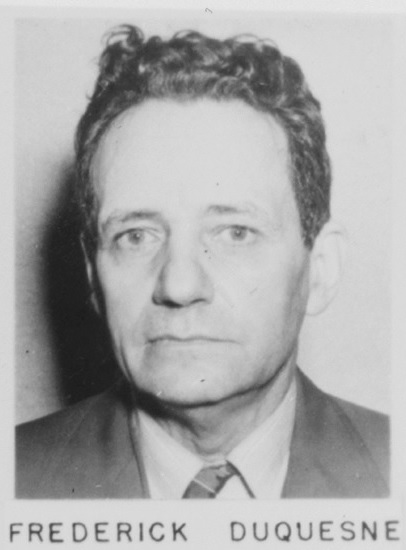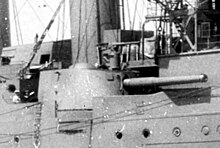HMS Hampshire (1903)
|
|
|
|---|---|
| Devonshire- class | |
 HMS Hampshire |
|
| Overview | |
| Type | Armored cruiser |
| Shipyard |
Armstrong, Whitworth & Co , Elswick , BauNr. 734 |
| Keel laying | August 20, 1902 |
| Launch | September 24, 1903 |
| delivery | July 15, 1905 |
| Namesake | Hampshire county |
| Whereabouts | Sunk on June 5, 1916 after being hit by a mine |
| Technical specifications | |
| displacement |
10,850 tn.l. |
| length |
overall: 144.42 m (473.5 ft ) |
| width |
20.89 m (68.5 ft) |
| Draft |
7.32 m (24 ft) |
| crew |
610 - 655 men |
| drive |
|
| speed |
23.47 kn |
| Armament |
|
| Coal supply |
800 (max. 1033) ts |
|
Armor belt armor |
|
| Casemates |
152 mm (6 in) |
| deck |
51 mm (2 in) |
| Command tower |
305 mm (12 in) |
| Barbeds |
127 or 152 mm (5 or 6 in) |
The HMS Hampshire was a Devonshire-class armored cruiser of the British Royal Navy . She was built at the Armstrong-Whitworth shipyard in Elswick and was launched on September 24, 1903 as the first cruiser of the class and, like the five sister ships, came into service in 1905. At the beginning of the world war she was at the China station , but already in the first year of the war she moved to various stations at home. On June 5, 1916, she sank after being hit by mines near the Orkneys when she was supposed to bring the British Minister of War, Lord Kitchener , to Russia. Out of a crew of more than 600, only twelve reached the coast on two Carley rafts; Kitchener and his staff died.
Building history
The HMS Hampshire was one of six Devonshire class ships. This armored cruiser class, built from 1902 to 1905, was an attempt to improve on the previous Monmouth class .
The two 152 mm twin towers in this class were replaced by 191 mm (7.5 in) single towers. While the ships were still being built, it was decided to replace the front casemates, which were planned one above the other, with two more individual towers. This gave the cruisers an armament that was on a par with the armored cruisers of other nations and gave them an artillery predominance over smaller cruisers. The heavier artillery only led to a small increase in size. The armor of the ships was thicker, but also narrower. In terms of drive, the class was used to test different types of boilers. In the front rooms there were water tube boilers in different designs depending on the manufacturer. The rearmost boiler room in all ships had six cylinder boilers . Outwardly, the Royal Navy returned to four chimneys with the Hampshire and her sisters.
The class is always referred to in literature as the Devonshire class, the keel-laying of which took place on March 25, 1902 at Chatham Dockyard as the first ship. The keel laying of the five sister ships took place until October 1 of that year at five other shipyards, the HMS Hampshire on September 1, 1902 at the Armstrong shipyard on Tyne, where the armored cruiser was launched on September 4, 1903 as the first ship of the class ran. On July 15, 1905, she was then accepted into the service of the Royal Navy as the third ship of the class.
Mission history
The HMS Hampshire initially served in the Channel Fleet with the 1st cruiser squadron together with four sister ships (except for the Carnarvon, which was used in the Mediterranean ). In December 1908 she was taken out of service for an overhaul in Portsmouth . In August 1909 she came back into service for the 3rd Division of the Home Fleet , where she was used again with four sister ships (only the Argyll was in the Atlantic Fleet). 1911 moved the Hampshire to the 6th cruiser squadron in the Mediterranean fleet . Due to the tense situation in China, it was soon transferred to the China station, where it remained until the outbreak of war in 1914.
War effort
On July 26, 1914, the Hampshire met in the main association of the China station from a trip u. a. to Vladivostok together with HMS Minotaur , HMS Yarmouth and five destroyers back in Weihawei . In order to replenish their supplies, the ships continued to Hong Kong , which was left on August 6th together with HMS Triumph , HMS Newcastle , the French cruiser Dupleix and other units to provide German units and their suppliers. At sea, Minotaur , Newcastle and Hampshire separated from the association and tried to intercept the SMS Emden on the way to the cruiser squadron, which had recently left the German base in Tsingtau . The Hampshire provided the supply steamer Elsbeth (1651 GRT, 1800 t coal, Jebsen shipping company ), which had left Tsingtau on July 31, and sank it. The Hampshire was then released to Hong Kong to dock there because of its excessive use of coal. All ships of the Devonshire class had this characteristic , which is why they were rarely used on overseas stations. The association of other British ships running towards Tsingtau with the liner Triumph was supposed to give the impression through its radio operation that the cruisers were still with him. Minotaur and Newcastle ran on to Yap and destroyed the German radio station without finding any more German ships.
The ships of the China Station then controlled the shipping traffic from the Chinese coast in order to make further supplies impossible without knowing where the German cruiser squadron under Vice Admiral Graf Spee had actually ended up. When Japan entered the war, the Royal Navy gave up security north of Hong Kong. The Minotaur , Hampshire and Yarmouth now searched the coasts of Java and Sumatra , with the Japanese cruisers Ibuki and Chikuma soon assisting them. When the first news of an operation of the Emden in the Bay of Bengal became known on September 15, 1914 , the Hampshire ran there and coordinated the search, supported by Yarmouth and Chikuma , while Minotaur and Ibuki patrolled off Indonesia to allow the Emden to march back into the Prevent pacific. During the first Anzac convoy with 38 transporters, which were supposed to transport about 30,000 Australian and New Zealand soldiers and 10,000 horses to Egypt, the light cruiser HMAS Sydney was sent to the Cocos Islands , which were attacked by the Emden , and was able to catch the German cruiser on 9 November 1914 turn off there. This meant that there was no longer any immediate threat to the convoy and the Hampshire took over the command off Colombo on November 13 , while the previous command cruiser Minotaur was sent to South Africa to stop the Spees squadron, which had eliminated the Cradocks squadron on the west coast of South America . The Hampshire accompanied the Australian and New Zealand troops to Suez and then ran on to the homeland, where it arrived on January 11, 1915 in Plymouth .
In January 1915 she was assigned to the 7th Cruiser Squadron and in November 1915 sent to the White Sea for trade protection. After returning, the Hampshire came to the 2nd Cruiser Squadron with Minotaur as the flagship, the HMS Cochrane and the HMS Shannon , which marched with the Grand Fleet to the Skagerrak on May 31, 1916 , but did not intervene actively in the battle . After the battle, she took the British Minister of War, Lord Kitchener, on board with his staff to take him to northern Russia, from where he would travel to Saint Petersburg for negotiations .
The loss of the Hampshire
Lord Kitchener and his staff boarded the Hampshire at Scapa Flow to go to Arkhangelsk . Since there was a strong storm, the cruiser was supposed to run through the Pentland Firth and then north along the western Orkney coast. This course was supposed to provide enough protection that the destroyer escorts could keep up with the Hampshire . The Hampshire dropped anchor at 4:45 p.m. and about an hour later hit the two Acasta-class destroyers , HMS Unity and HMS Victor . As the association picked up speed, the storm had grown stronger and the wind had changed its direction slightly, so that the chosen route was no longer advantageous and the destroyers fell back immediately. Since it seemed unlikely that enemy submarines would attack in the weather, the commander dismissed the destroyers.
When the Hampshire was about 1.5 miles from Orkney between Brough of Birsay and Marwick Head at about 7:40 p.m. , an explosion occurred and she was immediately listed to starboard. The cruiser had a huge leak between the bow and the bridge and the lifeboats could not be brought into the water because of the heavy seas and the list. About 15 minutes later, the decreased Hampshire at the position 59 ° 7 ' N , 3 ° 23' W . Only twelve men on two Carley rafts reached the coast; Kitchener and his staff were lost. The ship's commander, 46-year-old Herbert John Savill of the Royal Navy, was also killed.
The graves of over 100 sailors driven dead are in the Lyness Royal Naval Cemetery on the island of Hoy (Orkney) with a memorial stone. 650 men were killed.
The Hampshire had run into one of the mines that the German submarine U 75 under Kurt Beitzen had laid shortly before the Battle of the Skagerrak on May 28, 1916 in order to block one of the exits from Scapa Flow.
Alleged attack on Kitchener

The German spy Fritz Joubert Duquesne claimed to have controlled the sinking of the ship. Allegedly he received the Iron Cross for this . A portrayal of William Faro, who claims that Duquesne boarded the ship in Scotland and gave a signal to a German submarine as Kitchener's ship approached, seems difficult to understand. He had brought himself to safety on a lifeboat before sinking.
literature
- Peter Brooke: Warships for Export: Armstrong Warships 1867-1927 . World Ship Society, Gravesend 1999, ISBN 0-905617-89-4
- Roger Chesneau, Eugene M. Kolesnik (Eds.): Conway's All The Worlds Fighting Ships, 1860-1905. Conway Maritime Press, London 1979, ISBN 0-85177-133-5 .
- JJ Colledge, Ben Warlow: Ships of the Royal Navy: the complete record of all fighting ships of the Royal Navy. Chatham, London 2006, ISBN 1-86176-281-X .
- Bodo Herzog: 60 years of German submarines 1906–1966. JF Lehmanns Verlag, Munich 1968.
- Carl Herbert: War voyages of German merchant ships. Broschek & Co publishing house, Hamburg 1934.
- Bruno Weyer: Taschenbuch der Kriegsflotten 1905. 2nd edition. JF Lehmann Verlag, Munich as Dreischornsteiner (on archive.org)
- Eric Hall McCormick: The Mystery of Lord Kitchener's death . Putnam, London 1958.
- Kitchener. Lord overboard . In: Der Spiegel . No. 22 , 1959 ( online ).
Web links
- HMS Hampshire memorial site
- Hampshire Devonshire -class
- Devonshire Class Cruiser
- Hampshire's log books on oldweather
Individual evidence
- ↑ British 7.5 "/ 45 (19 cm) Mark I
- ↑ The Alliied China Squadron. (PDF) In: Naval review. 1915, p. 312ff.
- ↑ Herbert, p. 67.
- ↑ Herzog, p. 120.
- ↑ Overview of various theories ( Memento of the original from March 24, 2013 in the Internet Archive ) Info: The archive link was inserted automatically and has not yet been checked. Please check the original and archive link according to the instructions and then remove this notice.
- ↑ Clement Wood: The man who killed Kitchener; the life of Fritz Jouber Duquesne . William Faro, New York 1932.
